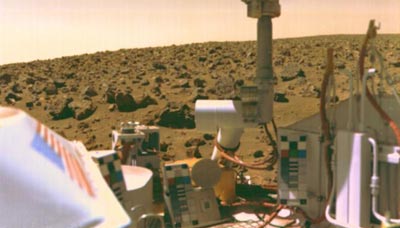Cleaning up after Martian exploration<< page 1: biologically reversible exploration Varying reactionsMcKay then turned the plenary session over to a panel of experts who debated the merits of his proposal. The panel included Robert Zubrin, founder of the Mars Society and arguably the strongest individual proponent for human exploration of Mars in the world. Zubrin made it clear in his comments that he was opposed to the concept of biologically reversible exploration. “This is impractical and not cost-effective,” Zubrin said. He noted that if any life does exist on Mars, it does so in subsurface aquifers of liquid water, well out of the reach of terrestrial bacteria on the surface. Reengineering spacecraft to conform to reversible exploration, or retrieving existing spacecraft, could incur costs in the tens of billions, he believes. “If you stick a requirement into the mission that the mission must be engineered in such a way such that no non-reversible contamination could potentially be allowed to occur, that is horrendous,” he concluded.
Penny Boston, an astrobiologist who has spent much of her career studying extremophile lifeforms in terrestrial caves, is more open to the concept. “It is not undoable to protect Mars,” she said. “It’s something that could be built into the program.” She said she believes that such exploration could be carried out without resorting to Draconian measures, and that the amount of knowledge that could be gained by studying a pristine second genesis would be “immeasurable.” James Heiser, a Lutheran minister and Mars Society member from Texas, hedged when asked about the ethical and philosophical issues of biologically reversible exploration. “It’s an ethical mess,” he concluded. “We have to take a certain amount of risk.” He noted, though, that reversible exploration does carry with it risks of its own: it might better in some cases to leave the spacecraft where they are rather than risking making mistakes trying to retrieve them. Zubrin, however, stuck to his belief that biologically reversible exploration would hinder the human exploration and eventual settlement of Mars. His argument, in essence, was that humanity must eventually make a decision whether Mars should be home to humans or Martian microbes, a decision that Zubrin has already made for himself. “A Mars that is inhabitable only by microorganisms is much less interesting than one inhabitable by humans,” he said.
McKay, likewise, was not swayed by Zubrin’s arguments. “We don’t know if life exists on Mars, so we want to make reasonable choices,” he said. “We should try to do what is prudent to keep our options open.” Conducting biologically reversible exploration, McKay argued, was worth the extra effort for several reasons. It upholds the fundamental ethical principles of life, and also preserves the benefits that could come from the study of a second genesis of life. An eventual restoration of the Martian biosphere, he believes, “would be a good deed for a spacefaring people.” “We need to open up a dialogue” about biologically reversible exploration, McKay concluded. “It’s going to be hard to justify not doing it. We don’t want to be in a position such that 40 years from now that we look back and realize that we didn’t think it through in the first place and we’ve done something stupid that can’t be fixed at all.” Home |
|
